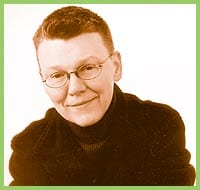The subtitle of Jennifer Boylan’s memoir She’s Not There: A Life In Two Genders is somewhat misleading – after all, it’s not as though Boylan ever thought she was anything other than female. Early in the book, she talks about how, at three, she was aware that, “I was in the wrong body, living the wrong life.” That her physical reality was at odds with her internal reality is the dominant theme in the book, and the issue that she struggled with for the first 40 years of her life.
There are a couple of features in this memoir that give it an edge. Boylan, as James Boylan, had some success as a writer of fiction (though I confess to not having heard of any of his three novels: Getting In, The Planets and The Constellations) and is the co-chair of the English department at Colby College in Maine. And Boylan once shared an office at Colby with a more famous fiction writer, Richard Russo, winner of the Pulitzer Prize.
The memoir is well written and for the most part well constructed. She works hard to inject her particular sense of humour into the book. On hormone therapy, for instance, she writes, “Well, the one pill makes you want to talk about relationships and eat salad. The other pill makes you dislike the Three Stooges.”
Boylan gives a pretty straightforward account of growing up with a nagging sense of being different, of being something other than what’s expected while at the same time appearing to be outwardly “normal.” It’s a classic tale of the geek who’s not so out there as to draw attention to himself and not quite fitting in either. That pretty much describes Boylan’s strategy for his entire career as a guy – a little different but not wildly so.
Believing that love would save him from his dilemma, he got married and had two children and lived pretty much like a regular heterosexual male. Occasionally, he would cross- dress but took absolutely no risks. His wife, the much praised and admired Grace, had no idea whatsoever about his trans condition.
The major weakness in the book (or perhaps in the person, who knows?) is the way that Boylan doesn’t get why the people he has been close to are confused and ambivalent about his decision to transition. As James, he did such a thorough job of suppressing his own conviction about his true identity that the people closest to him had absolutely no idea that he wasn’t what he appeared to be. There’s no question that Jenny’s struggle is far more complex for her than it is for anyone else, but her attitude toward reactions that are anything less than fully validating are obnoxiously self-absorbed.
If one of the classic suspicions about male-to-female transsexuals (MTFs) is about the way, as boys, they managed to miss out on the early indoctrination in the ways of gender-based oppression, Boylan works hard to remind us of the constant struggle and the immense pressures of living a false life. As she describes it, her life consisted of a deeply internal battle over how to be who she perceived she was and how to continue living the life he had constructed in order to avoid the overwhelmingly difficult path of the transgendered. Who needs external oppression when you’ve been so internally oppressed?
What doesn’t become clear in the narrative is the question of what’s next in terms of sexual orientation for Jenny. She’s still married to Grace, which is one of the great ironies, since they’re both legally women – but their post-surgical relationship is described as “sisterly” and there is no hint given about their sexual life. Given that this is, after all, a highly personal account it’s odd that Boylan doesn’t have much to say about how she sees herself sexually. She does insist that for her, her choice was about matching her true identity with her public one.
In fact, she writes, “My conviction, by the way, had nothing to do with a desire to be feminine, but it had everything to do with being female. Which is an odd belief for a person born male. It certainly had nothing to do with whether I was attracted to girls or boys. This last point was the one that, years later, would most frequently elude people, including the overeducated smarty-pants who constituted much of my inner circle. But being gay or lesbian is about sexual orientation. Being transgender is about identity.” That’s fine, but whom is she attracted to?
It is early days for Jenny after all. It wouldn’t be surprising to find that there was a sequel in the works – She’s Back, perhaps?
* Maureen Phillips writes on books in every other issue.
SHE’S NOT THERE: A LIFE IN TWO GENDERS.
Jennifer Finney Boylan.
Broadway Books.
300 pages. $37.95.

 Why you can trust Xtra
Why you can trust Xtra


